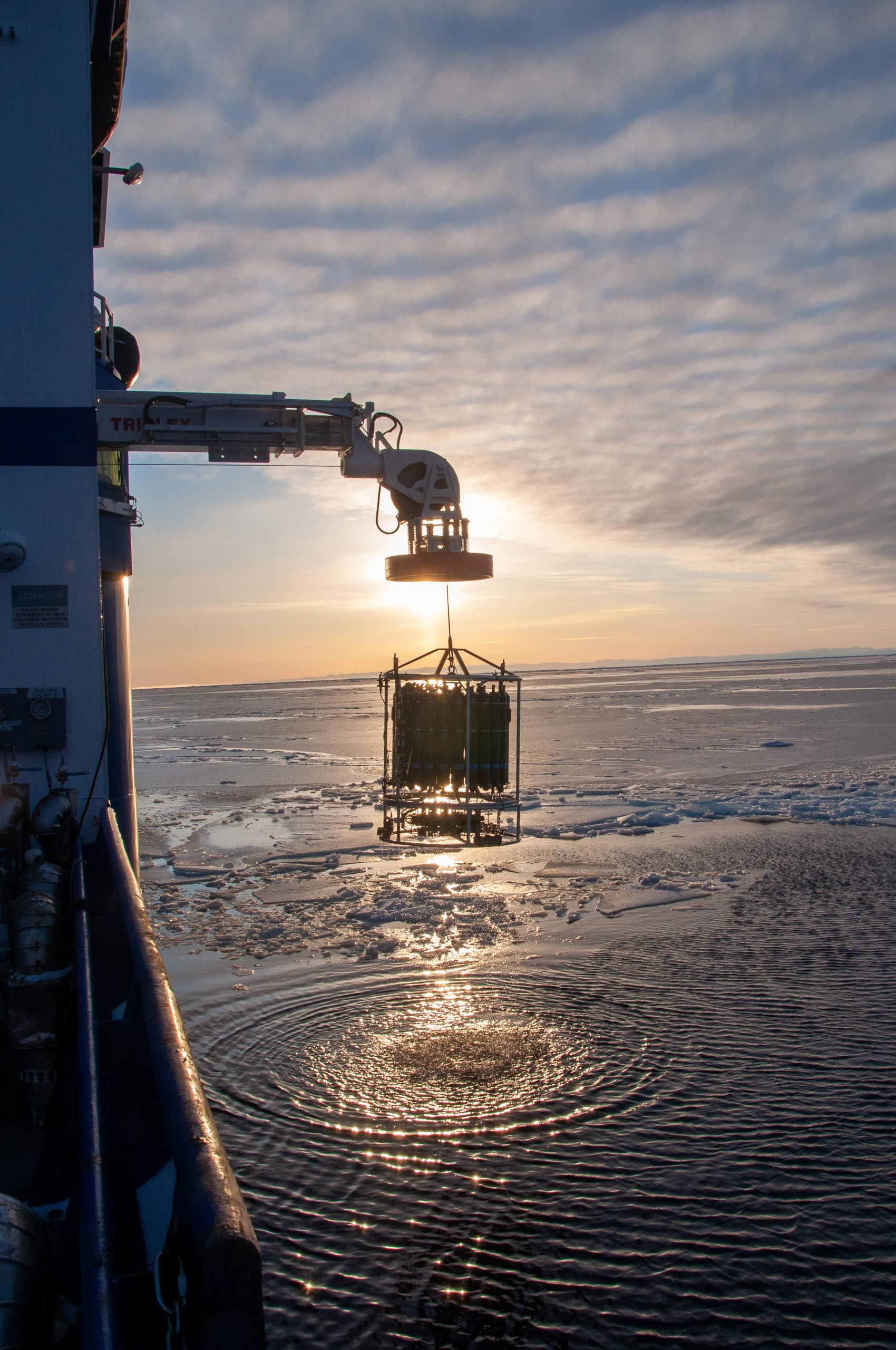
西北極海である氷の端から測定値を収集します。 クレジット: Peigen Lin/Woods Hole Oceanographic Institution
最近の研究は、カナダ盆地の支配的な循環であり、北極海で最大の淡水貯蔵庫である高気圧性ボーパート還流の安定化の初期観測の証拠を提示しました。
この研究では、2003年から2019年までの包括的な水路データセットとともに、2人の共著者が提供した2011年から2019年までの最近の長期化された「動的海洋地形」衛星情報記録を活用して海洋の進化を測定します。します。 近年の還流の海面高さ。
2014年までに、以前の動的海洋地形データに依存した以前の観測とモデリングは、還流が強化され、1970年代の気候学と比較して淡水含有量が40%増加したことを文書化しました。 還流の安定化は巨大な淡水放出の前兆となる可能性があり、これは地球気候の重要な構成要素であるアトランティック・メリディナル・オーバーターニング・サークル(AMOC)に影響を与えることを含むかなりの影響を及ぼす可能性があります。
Beaufort Gyreは、「還流の海面高さの増加が鈍化し、淡水含量が停滞する準安定状態に移行しました。の流入の増加により、大西洋の温暖/塩水を深海で隔離する寒冷塩分層がかなり薄くなった。南東に移動したことに関連しています。」
Sunrise at the ice horizon in the western Arctic Ocean. Credit: Peigen Lin/Woods Hole Oceanographic Institution
“Our results imply that continued thinning of the cold halocline layer could modulate the present stable state, allowing for a freshwater release,” the article states. “This in turn could freshen the subpolar North Atlantic, impacting the AMOC.”
Because there could be many potential local and remote impacts of the changing gyre on the hydrographic structure, physical processes, and ecosystem of the Arctic, “it is of high interest to better understand the factors associated with such changes—including the underlying causes,” the article notes.
“People should be aware that changes in the circulation of the Arctic Ocean could threaten the climate. It’s not only the melting ice and animals losing their habitat that should be a concern,” said Peigen Lin, lead author of the paper. Lin, who is an associate professor at the Shanghai Jiao Tong University’s School of Oceanography in China, conducted his research as a postdoctoral investigator at the Woods Hole Oceanographic Institution (WHOI) in Massachusetts.
With the gyre being the Arctic Ocean’s largest freshwater reservoir, “if that freshwater gets released and ends up spreading into the North Atlantic, it could impact the overturning circulation, and, in an extreme case, disrupt it,” said co-author Robert Pickart, a senior scientist in WHOI’s Department of Physical Oceanography.

Collecting measurements in the ice, the western Arctic Ocean. Credit: Peigen Lin/Woods Hole Oceanographic Institution
The study, which includes an examination of long-term trends of the Beaufort Gyre and the causes of the thinning of the cold halocline layer, quantifies the evolution of the gyre in terms of its sea surface height as well as its freshwater content. “Both of these indicate that the Beaufort Gyre has stabilized in the second decade of this century,” Lin said.
The study also addresses the causes of the halocline thinning considerably as the gyre has evolved. The study notes that the recent decrease in the amount of Pacific origin winter water exiting the Chukchi Sea explains some of the thinning, and that the enhanced influence from the eastern Beaufort Sea – due to the gyre’s southeastward shift– likely also contributes to the thinning.
The recent documented state of the gyre “does not represent a return to the initial condition of 2003 when the gyre was weak and located partially in the southeastern basin. Instead, under the strengthened wind stress curl, the gyre has continuously intensified even though it has contracted, and it has maintained its excess freshwater storage,” the article notes.
Lin said a goal regarding the gyre is to understand the mechanisms behind its changes, which ultimately could allow scientists to predict what the gyre might do in the future.
“The community has been confounded by the fact that this gyre has kept growing and growing, and everyone is expecting it to release,” Pickart said. “Wouldn’t it be something if the gyre system and its freshwater accumulation and release could become somewhat predictable? Then, perhaps, we could also shed light on what a warming climate is going to do to this system.”
Reference: “Recent state transition of the Arctic Ocean’s Beaufort Gyre” by Peigen Lin, Robert S. Pickart, Harry Heorton, Michel Tsamados, Motoyo Itoh, and Takashi Kikuchi, 8 May 2023, Nature Geoscience.
DOI: 10.1038/s41561-023-01184-5
The study was funded by the National Science Foundation; the National Oceanic and Atmospheric Administration; the Shanghai Pujiang Program and Shanghai Frontiers Science Center of Polar Science; the European Space Agency Project and Natural Environment Research Council; the Arctic Challenge for Sustainability projects of the Ministry of Education, Culture, Sports, Science and Technology, Japan; and the Arctic Challenge for Sustainability II (ArCS II).
Co-authors Harry Heorton and Michel Tsamados of University College London provided the updated dynamic ocean topography data from 2011-2019 for the study. Co-authors Motoyo Itoh and Takashi Kikuchi of the Japan Agency for Marine-Earth Science and Technology (JAMSTEC) provided the mooring data regarding the Beaufort Gyre source water.















+ There are no comments
Add yours